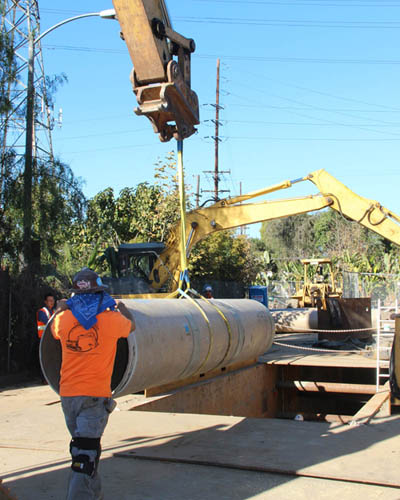Pipe Repair: Emergency Response In Compton
When the Sanitation Districts of Los Angeles County (LACSD) were formed in the 1920s, the agency embarked on its first major project -- the construction of the backbone trunk sewer of the Joint Outfall System (JOS). Since then, the Sanitation Districts have completed many challenging projects, providing environmentally sound, cost-effective wastewater and solid waste management services to over five million people in Los Angeles County.
The JOS of the LACSD is a large regional sewerage system consisting of 17 sanitation districts, serving 73 cities and unincorporated areas within Los Angeles County. The economies of scale and efficient operation of the large system have kept sewer rates in the Districts among the lowest of all California and U.S. sewerage agencies.
The Sanitation Districts own, operate and maintain approximately 1,400 miles of sewers that range in size from eight to 144-inches in diameter. They convey approximately 500 million gallons per day of wastewater to 11 wastewater treatment plants. Maintaining this enormous system is an ongoing challenge.

Curves that were not able to push through were relined by open-cut.
LACSD has been actively repairing sections of Joint Outfall “G” since 2009 with several phases previously rehabbed. The next phase of rehab was scheduled for an October, 2013 start-up in Compton. The existing Joint Outfall “G” Unit 9 is a 39-inch clay-tile-lined RCP pipe that was installed in the 1940’s along the current Interstate 710 Freeway which connects Pasadena to Long Beach. The freeway was built in the 70's and pipe had to be relocated to allow for this work. In the late 90's, it was observed that the cast-in-place clay tiles were falling due to corrosion in the mortar seal filling the gap between these tiles. Ultimately the tiles in the top half were lost and RCP was exposed to severe hydrogen sulfide corrosion.
The contractor on the most recent section, JO “G” Colich and Sons, LP of Gardena, California, had to rehab several junction structures. One of them was located in the intersection of Atlantic Street and Greenleaf Road.
“During excavation around the structure, the contractor exposed the 39-inch RCP sewer on the downstream end and found a short section of missing pipe crown. The upstream 39-inch RCP sewer was previously sliplined with Hobas 33-inch FRP and the downstream pipe was scheduled to be rehabilitated in the near future. After CCTV inspection it was determined that approximately 700 feet of sewer downstream of Manhole 847 was deteriorated and needed urgent repair. This emergency repair work was completed as a change order to the existing project,” stated Derek K. Zondervan, P.E., Civil Engineer, Sewer Design Section for LACSD.

Lightweight pipes were easily handled onsite, even with limited workspace.
In order to rehabilitate the deteriorated pipe, Hobas supplied 660 feet of 33-inch diameter flush joint pipe in 20-foot lengths and 60 feet of the same diameter in five-foot lengths. The short pipes were required due to the presence of curves in the existing line. “The reach included two short radius curves, one with a deflection of approximately four degrees near the downstream end of the 700-foot reach and a second with a deflection of approximately 25 degrees just downstream of Manhole 847 within the insertion pit. Five-foot sticks of Hobas pipe were pushed through the four degree curve and the 25 degree curve was lined by open-cut,” said Zondervan.
“Sliplining the existing 39-inch RCP with 33-inch FRP pipe was the preferred option because it avoided the need for a full above-ground flow bypass,” said Zondervan. Another reason that Hobas was chosen was the quick response from the pipe manufacturer. “Hobas was able to provide the material within the relatively short timeframe of two weeks,” said Zondervan. The capacity of the line post rehabilitation was still sufficient even though the diameter was decreased. “The daily peak flow in this reach is approximately 10 cfs and the capacity of the 33-inch nominal Hobas FRP after sliplining is approximately 18 cfs.,” explained Zondervan.
“The RFQ was received by our commercial department on November 25th, 2013, a purchase order was received on November 27th and pipe was shipped on December 5th,” stated Erin Boudreaux, marketing manager with Hobas Pipe USA. “ Once the cleaning was completed on December 10th, the sliplining was commenced the next day,” stated Bijan Khamanian, division manager, Hobas Pipe USA.

Pipes were easily pushed into position, and once installed, grouted in place.
Hobas has supplied over 200,000 feet of pipe to the joint outfall rehab program alone dating back to 1989. While many of these projects are planned investments as part of the County’s capital improvement program, some of these have been emergency projects.
Hobas manufactures pipe in sizes from 18 inches to 126 inches in pressure and non-pressure classes. For more information, please contact Hobas at 800-856-7473, 281-821-2200 or e-mail at info@hobaspipe.com. Facts are also available at www.hobaspipe.com.
